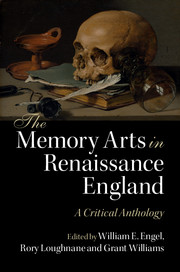Book contents
- Frontmatter
- Dedication
- Contents
- List of figures
- Acknowledgements
- A note on abbreviations
- Introduction
- PART I The art of memory
- PART II Rhetoric and poetics
- Introduction to Part II
- II.1 Anon., Table of Cebes (1531)
- II.2 Thomas Wilson, The Art of Rhetoric (1553)
- II.3 George Puttenham, The Art of English Poesy (1589)
- II.4 Henry Peacham, The Garden of Eloquence (1593)
- II.5 Philip Sidney, The Defence of Poesy (1595)
- II.6 Francis Meres, Palladis tamia (1598)
- II.7 Samuel Daniel, Musophilus (1599)
- II.8 Miles Sandys, Prudence (1634)
- II.9 Ben Jonson, Timber, or, Discoveries (1641)
- II.10 Alexander Ross, Mystagogus poeticus (1648)
- PART III Education and science
- PART IV History and philosophy
- PART V Religion and devotion
- PART VI Literature
- Index
- References
II.4 - Henry Peacham, The Garden of Eloquence (1593)
from PART II - Rhetoric and poetics
Published online by Cambridge University Press: 05 August 2016
- Frontmatter
- Dedication
- Contents
- List of figures
- Acknowledgements
- A note on abbreviations
- Introduction
- PART I The art of memory
- PART II Rhetoric and poetics
- Introduction to Part II
- II.1 Anon., Table of Cebes (1531)
- II.2 Thomas Wilson, The Art of Rhetoric (1553)
- II.3 George Puttenham, The Art of English Poesy (1589)
- II.4 Henry Peacham, The Garden of Eloquence (1593)
- II.5 Philip Sidney, The Defence of Poesy (1595)
- II.6 Francis Meres, Palladis tamia (1598)
- II.7 Samuel Daniel, Musophilus (1599)
- II.8 Miles Sandys, Prudence (1634)
- II.9 Ben Jonson, Timber, or, Discoveries (1641)
- II.10 Alexander Ross, Mystagogus poeticus (1648)
- PART III Education and science
- PART IV History and philosophy
- PART V Religion and devotion
- PART VI Literature
- Index
- References
Summary
About the author
Henry Peacham (1547–1634) served as a clergyman for over six decades and held rather unscrupulously two ecclesiastical livings at the same time. His son, also named Henry, was a famous emblem writer and author of the courtesy book The Complete Gentleman (1622).
About the text
Peacham is known primarily for his manual of approximately 200 figures of speech, The Garden of Eloquence, first published in 1577. Devoted to style, the third canon of rhetoric, his vernacular handbook helped students reference sophisticated literacy skills for reading and writing by analysing the ways in which language's form and content could be manipulated to achieve various persuasive effects. Peacham takes some of his examples from classical sources but relies heavily on biblical illustrations as befits his pastoral calling. Implementing the same Ramist diagram found in Johannes Susenbrotus's Epitome troporum ac schematum (1541), Peacham divides figures of speech into tropes and schemes and then further subdivides each – the first into tropes of words and tropes of sentences, the second under grammatical and rhetorical headings. The excerpt below does not appear in the first edition but only the enlarged edition of 1593, where he revises the division of the rhetorical schemes into three different orders, the second of which comprises thirty-seven ‘figures of affection’. Anamnesis belongs rather significantly to the fourth category of these emotive figures – the ‘figures of exclamation’. Interestingly enough, neither Susenbrotus nor Richard Sherry – nor George Puttenham too – cites anamnesis. This rare figure of speech does not even receive mention in Lausberg's authoritative Handbook of Literary Rhetoric. Quintilian, a likely source for Peacham, names it only in a list of figures specifically not found in Cicero, but offers no commentary.
The arts of memory
Anamnesis, an English transliteration of the Greek word, is etymologically derived from Plato's theory that we unconsciously possess knowledge from previous lives, and learning amounts to rediscovering it within ourselves. Peacham's label for the figure owes more to Aristotle's usage, which refers to the active recollection of thoughts in contradistinction to memory's passive storage-capacity. The excerpt reveals how deeply the memory arts penetrated into the texture of early modern discourse – maybe even more so than their classical forebears.
- Type
- Chapter
- Information
- The Memory Arts in Renaissance EnglandA Critical Anthology, pp. 120 - 123Publisher: Cambridge University PressPrint publication year: 2016



